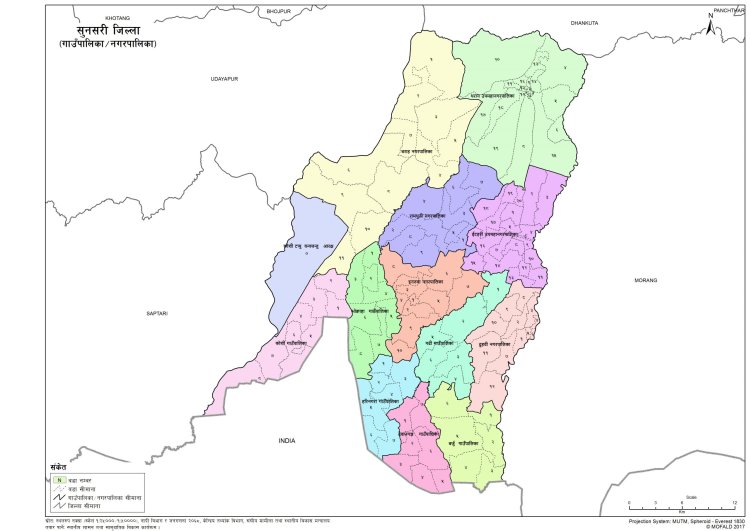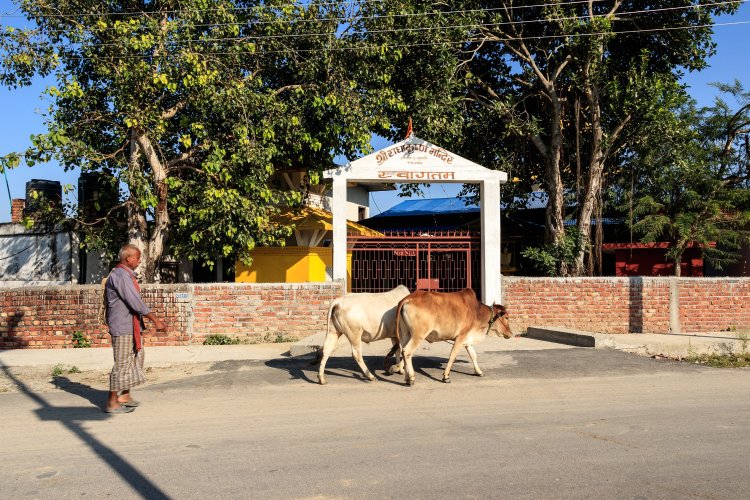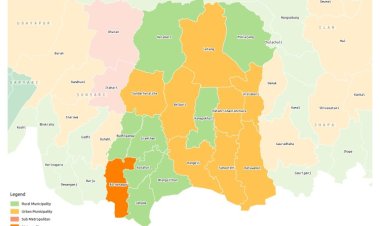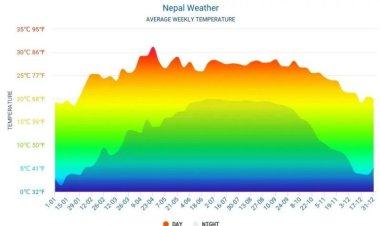Sunsari District in Nepal - Cultural and Natural Wonders
Discover the vibrant landscapes and rich traditions of Sunsari, Nepal, from its lush agricultural fields to the diverse ethnic communities. Experience the essence of Nepal in this dynamic district.
Introduction
Khotang is a district in Eastern Nepal, renowned for its wonderful landscapes and rich heritage. It is mainly a hilly area, lying in Province No. 1, with a few ethnic groups and some historical importance. This article provides information about the geography of the district, its demographics, cultural practices, must-visit attractions, and what awaits travelers on their journey.
Geographical Overview
Khotang District lies between latitudes 26°50' N and 27°28' N and longitudes 86°26' E and 86°58' E, covering an area of 1,591 square kilometers. The district headquarters, Diktel, has an elevation of about 1,192 meters above sea level. Its topography contains high hills, terraced fields, and dense forests, making it a paradise for nature lovers.
Climate
The topography of Khotang District is very diverse, ranging from lowland to highland, and its climate represents five climatic zones: lower tropical, upper tropical, subtropical, temperate, and subalpine. Its temperature fluctuates from an average of 6.9°C in winter to an average of 27.9°C in summer, while heavy rainfall prevails during the monsoon season.
Seasonal Breakdown
- Winter (December to February): The temperature drops significantly during this period, especially in the higher reaches. Snowfall is rare but possible in the highest regions.
- Spring (March to May): The weather warms up, and flowers and greenery bloom. It's an ideal time to trek as the weather is usually clear.
- Monsoon (June to August): This period sees heavy rains, refreshing the landscape; however, the hilly areas are prone to landslides.
- Autumn (September to November): This season usually offers a crystal-clear sky with moderate temperatures, making it another favorite time for trekking and other outdoor activities.
Main Rivers
The Sunkoshi and Dudh Kosi rivers serve as natural borders for the district, enhancing its natural beauty while being crucial for agriculture and daily life. These rivers are vital for irrigation and are also well-known for fishing and rafting.
Demographics
According to the census of 2021, Khotang District has a population of 175,298 people. The literacy rate is 76%, with a sex ratio of 1,023 females per 1,000 males. The population is predominantly rural, with most inhabitants engaged in agriculture.
Ethnic Composition
The district comprises various ethnic groups, enhancing its cultural richness, including:
- Kirat Rai
- Brahmins
- Tamangs
- Thakuris
- Dalits
Each ethnic group has its unique traditions, languages, and customs that contribute to the district's cultural diversity. Religion in Khotang is varied:
| Religion | Percentage |
|---|---|
| Hinduism | 52.20% |
| Kirat Mundhum | 36.20% |
| Buddhism | 8.34% |
| Christianity | 3.07% |
| Others | 0.19% |
Hinduism is the major religion, followed by Kirat Mundhum. The latter celebrates various festivals and rituals unique to their culture.
Cultural Heritage
Khotang is a culturally rich district, predominantly influenced by the traditions of the Kirat Rai. It falls under the category of Majha Kirat, meaning Middle Kirant, and has maintained its native customs and traditions for several centuries. Music and dance play vital roles in the celebrations and rituals of different ethnic communities.
Festivals
Festivals in Khotang are integral to cultural life:
- Buddha Jayanti: Celebrated primarily by Buddhists to commemorate the birth anniversary of Lord Buddha.
- Dashain: One of the biggest Hindu festivals in Nepal, celebrating victory over evil.
- Tihar: A festival of lights associated with animals like crows and dogs.
These festivals are celebrated with great enthusiasm through traditional music, dance, and communal feasting.
Handicrafts
The district is well-known for its craftsmanship in:
- Khukuri Production: Famous for high-quality khukuris, a traditional Nepali knife, produced by local artisans through generations.
- Metal Crafts: Various metallic handicrafts reflecting traditional designs are also produced.
Language
Nepali is the major language spoken in Khotang, though various ethnic groups use their mother tongues, including Rai and Tamang languages, adding to the district's cultural diversity.
Must-Visit Attractions
Khotang features numerous attractions that showcase its natural beauty and cultural richness, including:
Halesi-Maratika Caves
These are among the most sacred caves in Nepal and a major pilgrimage site for Hindus, often referred to as the "Pashupatinath of the East." They hold spiritual significance, particularly as the abode of several deities, including Lord Shiva.
Significance: It is believed that Lord Shiva meditated in Halesi-Maratika, attracting many devotees seeking blessings. The caves are adorned with intricate carvings and possess a mystic atmosphere that captivates visitors.
Barah Pokhari
This holy lake, located in Barahapokhari Rural Municipality, plays a vital role in local religious activities. Surrounded by greenery and hills, Barah Pokhari offers stunning views for trekkers and a peaceful meditation spot.
Things to Do: Visitors can enjoy boating or have picnics lakeside in a tranquil atmosphere.
Trekking Routes
Several trekking routes present breathtaking views in this district:
- Diktel Trek: Begins at Diktel Bazaar, leading through terraced fields and dense forests with panoramic views of the surrounding hills.
- Halesi Trek: A scenic trek from Diktel to Halesi-Maratika Caves, allowing trekkers to closely experience local culture.
- Local Villages: Visits to local villages like Sakela, Bhuwanchuli, or Manebhanjyang provide insights into traditional lifestyles. Locals are friendly and eager to share their culture.
Adventure Activities
For those interested in adventure beyond trekking, various activities are available:
- Rafting: The Sunkoshi River is famous for white-water rafting, suitable for both novices and experienced rafters, offering thrilling adventures amidst stunning scenery.
- Paragliding: Opportunities for paragliding in certain areas of Khotang provide guests with high-flying experiences over the hills, showcasing breathtaking views.
Local Cuisine
The diverse culture of Khotang is reflected in its culinary offerings:
- Dhido: A traditional dish made from buckwheat or millet flour served with vegetables or meat.
- Gundruk: Fermented leafy greens commonly eaten as a side dish.
- Sel Roti: A doughnut-like snack made from rice flour, often prepared during festivals.
These dishes are typically prepared in local eateries, accompanied by fresh vegetables from nearby farms.
Education in Khotang District
The education system is growing, with schools providing quality education, including:
- Government Schools: Free primary education is provided, ensuring access to education for all children.
- Private Institutions: A few private schools are available, offering education in both Nepali and English mediums.
Conclusion
Khotang District, with its stunning landscapes, rich culture, and welcoming locals, is a perfect travel destination for adventure seekers and culture enthusiasts alike. It is a place where nature and heritage come together, offering visitors a unique and memorable experience.
Frequently Asked Questions (FAQ)
Where is Khotang District located?
Khotang District is situated in Province No. 1 in Eastern Nepal.
What are some major attractions in Khotang?
Major attractions include Halesi-Maratika Caves, Barah Pokhari Lake, trekking routes around Diktel & Halesi.
What is the population of Khotang District?
As per the 2021 census data available currently shows approximately 175,298 residents living there.
What ethnic groups are found in Khotang?
The district comprises various ethnic groups including Kirat Rai people among others like Brahmins & Tamangs.
What types of cuisine can I expect?
Traditional dishes include Dhido (buckwheat dish), Gundruk (fermented greens), Sel Roti (rice-based doughnut).
How can I reach Khotang District?
Access via road transport from major cities or domestic flights connecting Thamkharka Airport nearby.
What adventure activities are available?
Rafting on Sunkoshi River & paragliding opportunities exist around certain areas within Khotang.
Is education accessible in Khotang?
Yes! Several schools provide education up until secondary levels; higher education requires travel outside sometimes but options exist locally too!
What's Your Reaction?









































































































